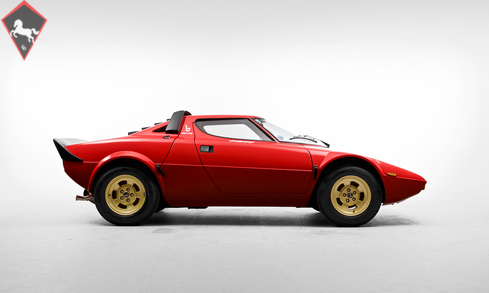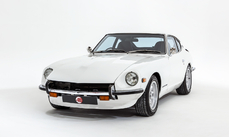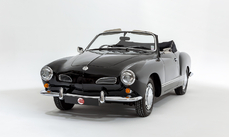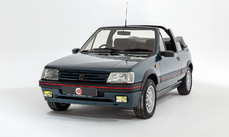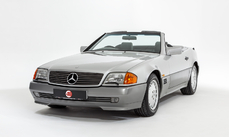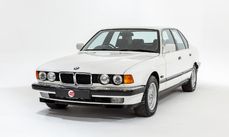Lancia Stratos HF 1977
General description :
One of just 492 Stratos HFs, fully restored and with 62k miles.
MODEL HISTORY
The Lancia Stratos HF (Tipo 829), widely and more simply known as Lancia Stratos, started production in 1973 and went on to become a very successful and iconic rally car, winning the World Rally Championship in 1974, 1975 and 1976. It was the first design project between Bertone and Lancia, who where well known for their design links with Pininfarina. Built as a Rally car to replace the Lancia Fulvia, the Stratos was based on the designs of Bertone's Marcello Gandini who also designed the Lamborghini Miura and Countach.
During early production it was decided to use a Ferrari Dino V6, however, Enzo Ferrari initially was not in agreement of this as he saw it as competition to his own Dino V6. Eventually when the production of the Dino ended Enzo Ferrari agreed on delivering 500 units to Lancia.
The Stratos was a very successful rally car during the 1970s and early 1980s. It started a new era in rallying as it was the first car designed from scratch for this kind of competition. The three leading men behind the entire rallying project were Lancia team manager Cesare Fiori, British racer/engineer Mike Parkes and factory rally driver Sandro Munari.
The car won the 1974, 1975 and 1976 Championships in the hands of Munari and Björn Waldegård, and might have gone on to win more had not internal politics within the Fiat group placed rallying responsibility on the Fiat 131 Abarths. As well as victories on the 1975, 1976 and 1977 Monte Carlo Rally, all courtesy of Munari, the Stratos won the event with the private Chardonnet Team as late as 1979.
Equipment
14-inch Campagnolo alloy wheels, Klippan harnesses, Sun visors, Heater, Roof spoiler, Rear spoiler, Rear window louvres, Electrical kill switch, Spare wheel.
EXTERIOR
The classic wedge styling of the Stratos still remains truly striking. The body presents as new throughout having been fully repainted to a very high standard by The Classic Car Workshop in 2015. Lancia specialists, Walkers Garage Ltd, oversaw the car's complete and thorough restoration and the result is one exceptional Stratos.
The body panel numbers are still visible inside the front clam and door shuts, and both the front and rear panels show no signs of any historical damage. The correct Stratos and Bertone decals have been freshly applied, and all trim pieces appear as new. The window louvers, roof and boot spoilers are also in excellent condition.
Chassis number: 829ARO 001744Body number: 1240 252
INTERIOR
The compact interior remains in very good condition with a lovely patina throughout. The black vinyl dash, headlining, and fawn suede seats are original and show no signs of excessive wear. Furthermore the dials and switchgear are all correct and operating exactly as they should with no electrical issues.
ENGINE & TRANSMISSION
Lifting the large rear shell reveals the wonderful Dino V6 power plant. In June 2015 the current owner spent over £14,000 with Walkers Garage to rectify any issues that were discovered after a full inspection and check over.
The work included but was not limited to: new hoses, brake and clutch lines, suspension refurbishment, oil service and filter replacement, airbox and header tank refurbishment, rolling road test and carb set up, new ignition system and sports coil, plus the fitting of bespoke stainless steel silencers and pipes. The gearbox also received treatment including new seals and fresh oil.
Engine number: 829A 000 001097
WHEELS, TYRES & BRAKES
The Stratos sits on the original 14-inch Campagnolo alloy wheels, finished in striking gold paint with the correct domed wheel nuts fitted. The alloys have been recently refurbished and look exceptional. Walkers Garage fitted a brand new set of Michelin XWX classic tyres last year and also replaced the brake lines and master cylinder.
HISTORY FILE
As one of only 492 Stratos HFs manufactured, this example was first registered in Austria on 17th April 1977. It was later imported to the UK in 2001 where its new owner would keep the car for the next thirteen years before it changed hands again in 2014. The current mileage of 100,994km is believed genuine.
Present in the history file is the UK V5C showing just two keepers. Also present are the original Austrian ownership documents that confirm the vehicle to be ‘matching numbers'. An invoice from Walkers Garage for the extensive work carried out completes the paperwork.
http://www.4starclassics.com/lancia-stratos-hf-for-sale/
1977 Lancia Stratos HF is listed sold on ClassicDigest in Kingsley by 4 Star Classics for £449995.
Car Facts
Car type : Car Make : Lancia Model : Stratos Model Version : HF Engine size : 2.4 Model Year : 1977 Sub type : Race/Rally Car Location : Hampshire
Sold
Seller Information
Sold
Other cars listed for sale by this dealer
About Lancia
Ah, Lancia, the Italian marque that danced on the edge of automotive brilliance! Let me take you on a journey through the captivating story of Lancia, a brand that embodies passion, innovation, and rallying prowess.Act 1: The Early Years (1906-1920s)
Lancia was founded in 1906 by Vincenzo Lancia, an engineering wizard with a flair for the extraordinary. The brand quickly gained a reputation for its precision engineering and innovative approach. The Lancia Alpha, introduced in 1907, was the first car to feature a narrow-angle V4 engine, setting the tone for Lancia's commitment to technical excellence.
Act 2: Innovation at its Core (1930s-1950s)
The 1930s saw Lancia pushing the boundaries of innovation with models like the Lambda, the first car to feature a load-bearing monocoque chassis. The Aprilia, introduced in the 1930s, showcased cutting-edge aerodynamics and a V4 engine, solidifying Lancia's reputation as a pioneer.
Act 3: Post-War Elegance (1950s-1960s)
After World War II, Lancia continued to dazzle with models like the Aurelia, the first production car to feature a V6 engine. It blended performance with comfort and elegance. The Flaminia followed, embodying luxury and advanced engineering.
Act 4: Rally Domination (1970s-1980s)
Lancia etched its name in motorsport history with an unparalleled rally legacy. The Lancia Stratos, a wedge-shaped wonder, dominated the rally scene in the 1970s, clinching three consecutive World Rally Championships from 1974 to 1976. The Delta Integrale, introduced in the 1980s, continued this rally reign with multiple championships.
Act 5: Struggles and Resilience (1990s-2000s)
The latter part of the 20th century brought financial challenges for Lancia, leading to collaborations with other automakers. Despite the difficulties, Lancia introduced models like the Thesis and the Ypsilon, showcasing its commitment to style and substance.
Act 6: 21st Century Reinvention (2010s-Present)
In the 2010s, Lancia faced a shift in strategy, focusing on the Ypsilon as its primary model. While production numbers dwindled, the brand maintained its reputation for distinctive design and comfort.
Epilogue: A Legacy of Passion and Innovation
Lancia's story is one of passion, innovation, and motorsport glory. The brand, with its groundbreaking designs, technological advancements, and rallying triumphs, has left an indelible mark on the automotive world. Lancia may have faced challenges in recent years, but its legacy lives on, celebrated by enthusiasts who recognize the magic woven into each Lancia creation. Finally, Here are some of the most important Lancia models that have left an enduring mark:
1. Lancia Lambda (1922-1931):
The Lancia Lambda is often considered a pioneering model, being the first car to feature a load-bearing monocoque chassis. This innovation set the stage for modern automotive design. The Lambda was available in various body styles and showcased Lancia's commitment to engineering excellence.
2. Lancia Aurelia (1950-1958):
The Aurelia, introduced in the early 1950s, was a groundbreaking model for Lancia. It was the first production car to feature a V6 engine, and it incorporated advanced engineering, including a rear transaxle and inboard rear brakes. The Aurelia set new standards for performance and comfort.
3. Lancia Flaminia (1957-1970):
Continuing Lancia's tradition of combining style with innovation, the Flaminia was introduced as a luxury sedan. It featured a V6 engine, a de Dion rear suspension, and avant-garde styling. The Flaminia further solidified Lancia's reputation for producing high-end, technically advanced vehicles.
4. Lancia Stratos (1973-1978):
The Lancia Stratos is an icon in the world of rallying. Born out of Lancia's rallying ambitions, the Stratos was purpose-built for competition. With its distinctive wedge-shaped design and a mid-mounted V6 engine, it became the first car to win the World Rally Championship three times consecutively from 1974 to 1976.
5. Lancia Delta (1979-1994):
The Lancia Delta is synonymous with rally success. It dominated the rally scene in the late '80s and early '90s, winning six consecutive manufacturers' titles in the World Rally Championship. The Delta's combination of performance, agility, and versatility made it an icon both on and off the rally stages.
6. Lancia Thema 8.32 (1986-1994):
The Lancia Thema 8.32 was a performance-oriented version of the Thema sedan, and it stood out for its collaboration with Ferrari. It featured a 3.0-liter V8 engine sourced from Ferrari, making it one of the few sedans with a Ferrari powerplant. This model showcased Lancia's ability to blend luxury and performance.
